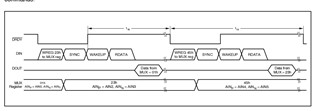Hi,
We use the ADS1256 for the data sampling funcation in our product, and now, the sampling accuracy is about 8%, which more different from 0.5% in the datasheet;
1. We use the RK3568 for the system control MPU, and the systme is linux;
2. We use the 100ohm resistance for the differential voltage sampling, when input voltage is 1.9554V, the measure voltage from ADC is 1.9550-1.9539V;
3. If we use the 10pcs 10ohm resistance to voltage subdivision, and the input voltage is 1.9554V, but the measure voltage from ADC is input voltage is 1.79xx-1.80xxV;
4. We set the data rate 1000SPS, and we measure the input multiplexer Cycling, and the t19 is 1.9ms which is diffenect from the datasheet t19 less than 1.19ms(837Hz);

5. The schmatic diagram for your evaluating:

